The house fly, Musca domestica, is a familiar insect pest. It is of economic importance because it can transmit disease-causing organisms, such as salmonella, e-coli, etc., and can be a nuisance in and around farms and houses.
Description
The adult is 5/32 to 17/64” long; the male is smaller than the female. Both sexes have sponging mouthparts, a thorax with four narrow stripes, and one pair of wings.
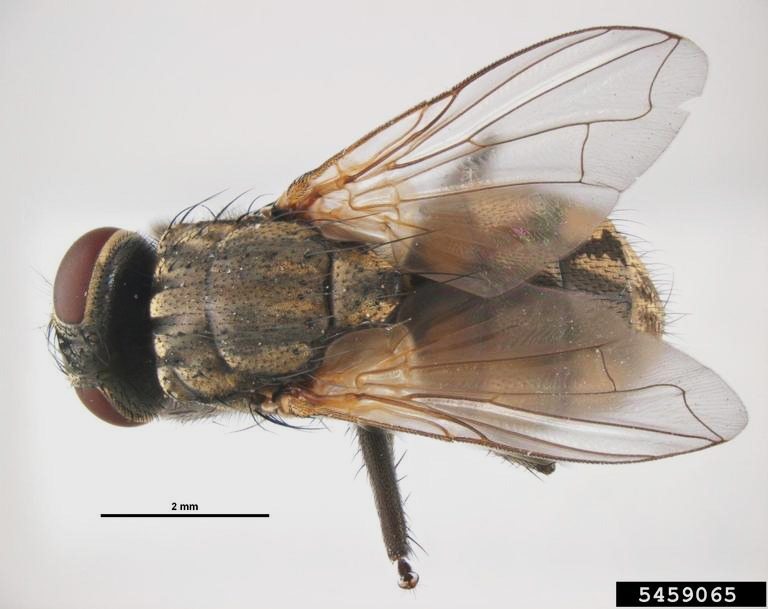
and Pest and Diseases Image Library (right), Bugwood.org.
The immature stage is called a maggot. The maggot is creamy white and legless. It is 17/64 to 25/64” long, it is pointed anteriorly and bluntly rounded posteriorly, and has no distinct head capsule.
The puparium varies from yellowish-red to black, depending on age, and is barrel-shaped. It is 5/32 to 17/64” long.
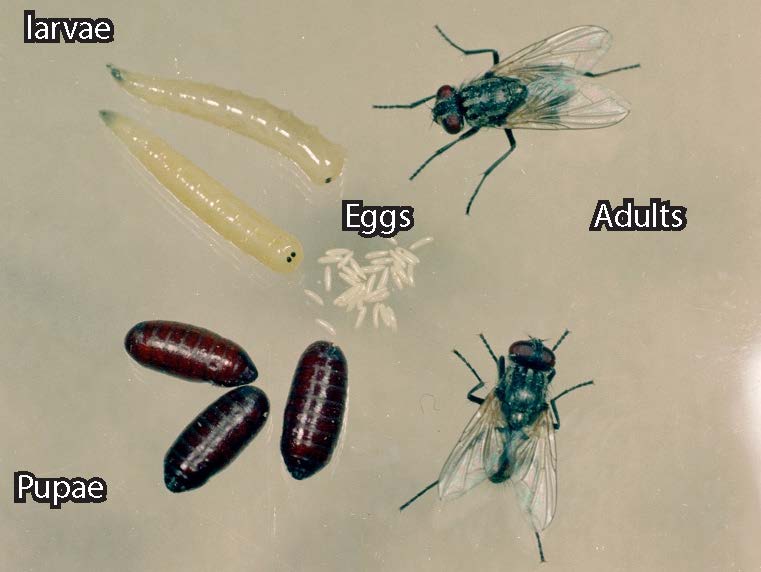
Extension Slide Series, Bugwood.org.
Life Cycle
In New Hampshire, house flies overwinter outdoors as pupae in such habitats as manure piles and organic debris. Some adults can survive the winter in heated buildings.
Each female lays from 75-150 eggs per cluster and in its lifetime will deposit from 350 to 900 eggs. The female deposits these eggs 4 to 12 days after emerging from its pupal case. The eggs are deposited in moist materials, such as fresh manure (less than one day old), manure mixed with hay or straw, and waste grains, hay, or straw. When piled up and allowed to remain moist, these materials provide ideal breeding sites for house flies and other pest flies.
The maggot emerges in 8 to 20 hours and begins feeding. Under favorable conditions, the larva goes through three stages of development in 3 to 7 days. Before pupating, the larva migrates to a drier locality at the edge of its breeding habitat. Depending on temperature and humidity, the adult emerges from the pupal case in three days to four weeks. There are six to eight generations per year.
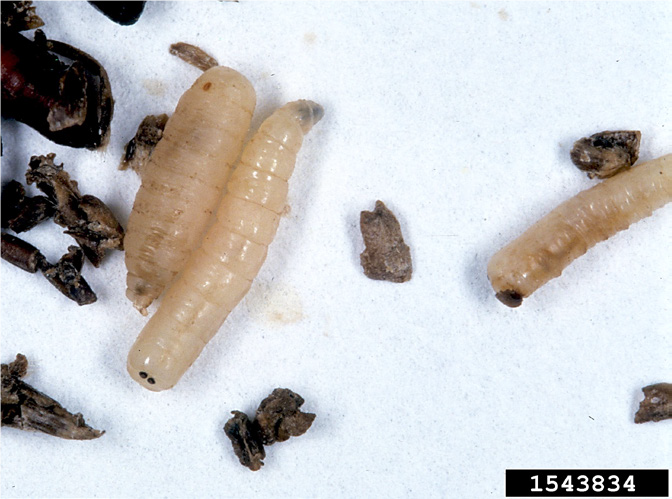
Bugwood.org.
Management
IPM Strategies:
- Sanitation - One of the most important practices for fly control is sanitation. Removal of manure bi-weekly, prevention of waste buildup, screening of the area, and hauling of the manure are good practices to employ. Manure spreading helps to reduce breeding by drying out the material. Composting manure can be effective if proper temperatures are reached.
- Cultural Practices - Never use straw as bedding as it is a favorite breeding material for these flies.
- Monitoring - Monitor flies with white sticky spot cards on livestock facilities. Spot cards are 3” by 5” white index cards attached to fly resting surface. A minimum of five cards should be placed in each animal facility and left in place for seven days. A count of 100 or more fecal or vomit spots per card per week indicates a high level of fly activity and a need for control.
- Biological control - In some livestock farm settings, purchasing and releasing parasitic wasps (several species are available commercially) can be an effective control if done properly.
- Chemical Control - When necessary, insecticides can be used. When using chemical sprays, it is important to rotate the insecticides you use, between materials with different modes of action. Using the same material repeatedly can cause house flies to become resistant to the pesticide.
For a more personalized recommendation consult your county Agricultural Field Specialist.
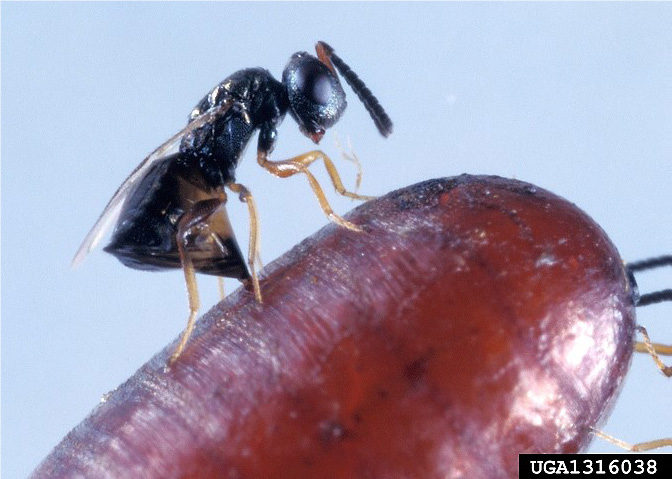
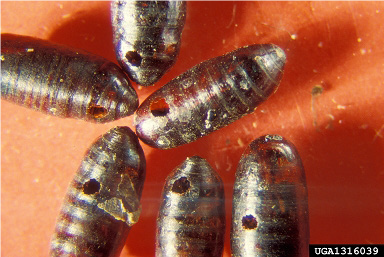
Research Service, Bugwood.org.
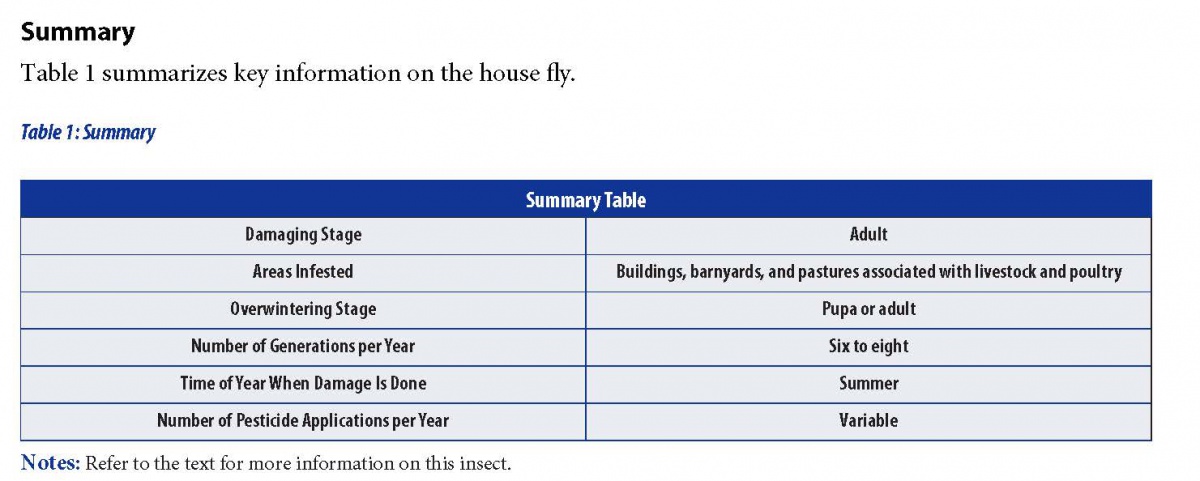 Stop! Read the label on every pesticide container each time before using the material. Pesticides must be applied only as directed on the label to be in compliance with the law. All pesticides listed in this publication are contingent upon continued registration. Contact the Division of Pesticide Control at (603) 271-3550 to check registration status. Dispose of empty containers safely, according to New Hampshire regulations.
Stop! Read the label on every pesticide container each time before using the material. Pesticides must be applied only as directed on the label to be in compliance with the law. All pesticides listed in this publication are contingent upon continued registration. Contact the Division of Pesticide Control at (603) 271-3550 to check registration status. Dispose of empty containers safely, according to New Hampshire regulations.
Download the resource for the complete factsheet.
